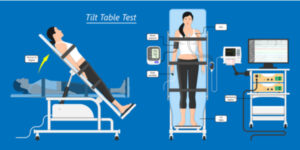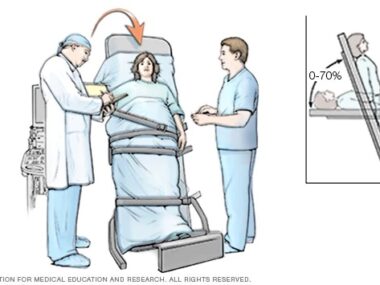Tilt Table Test Terrors!
In a tilt table test, you lie on a table that adjusts your body position from horizontal to vertical to simulate standing up. The test can tell your doctor if faulty brain signals are causing low blood pressure.
Above illustration & TTT description used with permission of Mayo Foundation for Medical Education and Research, all rights reserved.
Does every fainter need to take a tilt table test? That depends.
MY FATHER
Sometime in his mid-50s Dad was diagnosed with high blood-pressure. (We’re talking 1970s here.) For a few years, they said it was “white coat syndrome.” No, it was high blood-pressure. (He wasn’t nervous around doctors. His father & older brother had high BP too.) But for quite some time “white coat syndrome” was what the doctors swore he had. Finally, FINALLY, they decided he actually did have high BP & put him (I think) on a beta-blocker. Right before he turned 60 he started passing out on a regular basis. (Part of the problem was the medication. Because of dysautonomia it was dropping his BP too low. But we didn’t know any of this back then.) It was horrifying to witness him collapse. The first time he was walking to the bathroom. BOOM! Half of him was lying on the tile floor, half of him in the hallway. My sister was in nursing school & did all the things she was supposed to do. Dad came around & wanted nothing to do with going to a hospital.
LATENT DYSAUTONOMIA
The passing out became chronic. And every time it happened the cardiologist gave him a Tilt Table Test. It was the defacto procedure after every syncope. The problem is the test was kept going until he passed all the way out. EVERY TIME. After the third or fourth repeat of this experiment there was no medical need to do it that way. The reason I can say that is because after making my father pass out on the tilt table over & over again nothing was ever done for him. No diagnosis, no drug changes, no referral to a specialist. Besides, his heart rate/BP readings were clearly showing discrepancies as the table was going up. Dad could feel it so they had to see it. But they wouldn’t stop that test until he was unconscious. Dad finally refused to ever take the test again as there was clearly no purpose other than to cause unconsciousness. He wasn’t properly diagnosed with dysautonomia till 2001 – without the Tilt Table Test. Some meds were changed, others adjusted & then the intervals between pass outs grew much longer.

Another view of the dreaded Tilt Table Test.
INTERVIEW WITH MAYO DR HERE.
Many thanks to the Mayo Clinic for the use of their copyrighted materials. | Additional TTT Image by rumruay




